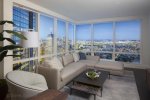- Joined
- Jul 6, 2020
- Messages
- 34
- Reaction score
- 19
- Age
- 77
True story. Following up on my "must launch from garage roof" post...The job required a panoramic view mural 8ft hi and 26ft wide to show the view from a new condo tower at 380 ft AGL, day & evening. The solution used the 24mm lens on X7, breaking the pano up into 24 parts: a grid of 3 vertical x 8 horizontal, overlapping. Recombine in Lightroom "PhotoMerge." Several attempts at this were made, and all of them stitched up very well, although each one had some stitching errors (bricks, window mullions, antennas) that could be fixed. Gimbal yaw was used to move the camera, instead of turning the AC, to minimize parallax on nearby buildings. Day exposures easy. Twilight exposures f2.8, 1/8 sec, ISO 800...surprisingly good, with noise that could be reduced in post. Finished pano was 19,000 pixels wide x 5400 px high. Then fixed, adjusted, and scaled up. I would not have believed such a thing possible. FOV - approx 130 degrees. Contact me off-line for more info and sample. Thanks to those who gave helpful advice, all much appreciated. (BTW - many, many tests in advance, to confirm technique.)






